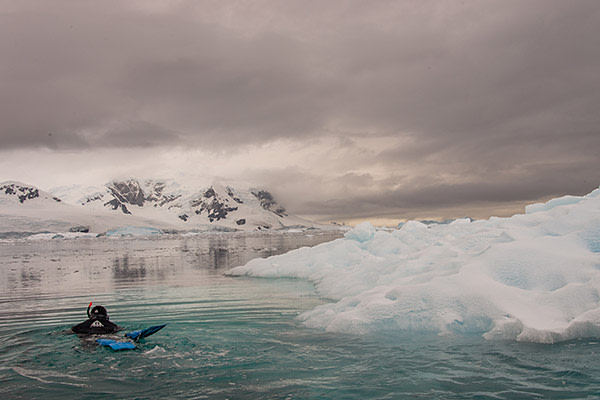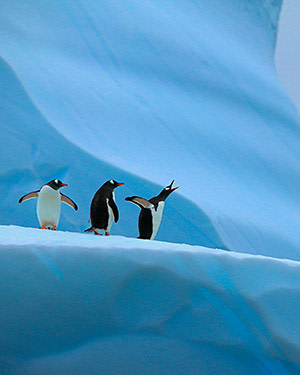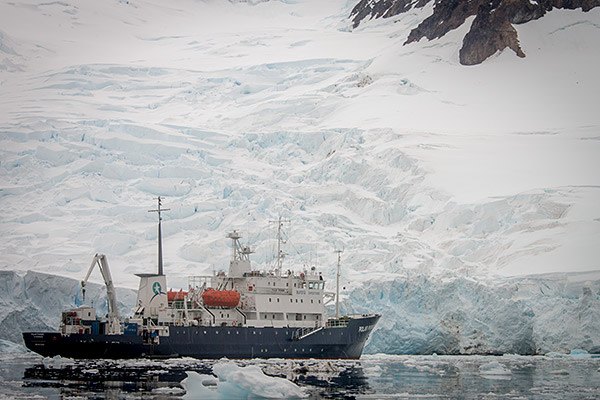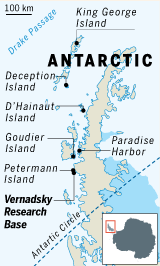Snorkelling in Antarctica

Simply sign up to the Life & Arts myFT Digest -- delivered directly to your inbox.
What a spiffing day for a dip: driving snow, a water temperature of 1C and our inflatable Zodiac boat being eyeballed by a leopard seal with the stare of an assassin and fangs of a vampire.
We putter towards an iceberg, don fins and masks, and slip overboard. Immediately I’m surrounded by sinuous frozen architecture worthy of Zaha Hadid but laced with the exquisite carving and snaking tunnels of a medieval stonemason: a ghostly sub-aqua citadel at the end of the world.
Once tourists taking an Antarctic “trip of a lifetime” were happy to stand on the deck of their cruise ship and admire the scenery and the penguins through binoculars. Increasingly, though, tour operators have been adding more adventurous activities to the mix – visiting scientific research stations, hiking, kayaking, skiing and even spending a night camping on shore. My cruise, run by adventure specialists Aurora Expeditions, is the first to offer a new option – not just watching the penguins but jumping in and snorkelling alongside them. Howard Whelan, expedition leader on the 10-day voyage around the Antarctic Peninsula’s bays, islands and inlets, calls it “stepping through the looking glass”.
While the trademark of a good snorkelling site never changes (clear water shallow enough to see the seabed or reef) there’s one obvious difference here – the breathtaking cold. On each of our 10 scheduled snorkels at different points along the peninsula – a timetable dependent on Antarctica’s fickle weather – we’ll spend 30 to 45 minutes face down in water between 0C and 3C. Around icebergs, the temperature can fall a further 2.5C.
Our saviour is technology. I’ll be wearing a state of the art snorkelling dry suit specifically developed for these trips by Waterproof Expeditions, a leader in the field of polar sub-aqua, to whom Aurora subcontracts the diving services on its cruises. The three-layered dry suit, which contains nylon and butyl, a synthetic rubber, and has more flexible neck and wrist seals, is light, comfortable and easy to put on.
It doesn’t work alone – underneath I’m wearing Merino wool base and mid-layers along with fleecy pants, while a neoprene hood and gloves protect my head and hands. Water intensifies heat loss 30 to 40 times – this gear should cut that figure to five times.
Before we put it to the test, we have to reach the Antarctic Peninsula. After leaving Ushuaia on Tierra del Fuego, the small ice-strengthened Polar Pioneer – formerly part of the Soviet hydrographic service – takes two days to bring its 52 guests, 25 Russian crew, and 12 Aurora and Waterproof staff across the queasy swell of the Drake Passage. The onboard atmosphere is highly convivial but, within its compact lecture theatre, talks on wildlife and environmental etiquette are combined with rigorous safety instruction.
We learn that our week of cold water immersion might reduce our core temperature by up to a degree, risking the creeping lethargy and pre-flu symptoms of silent hypothermia. We must always snorkel with a buddy within hearing distance of the guides, regularly search for eye contact with them – the Zodiac is usually 10 to 20 metres away – and use the OK signal. “There’s no room for risk taking,” warns lead diver Martin McGrath. “You’re doing something very simple in one of the most dangerous places on Earth.”

Clearly the thrill is not just seeing what lies beneath; it’s also about surviving the elements. “What are you wearing?” asks an Australian snorkeller en route to our first plunge.
“Two thermals. Two socks,” I reply.
“That’s all? I’ve three socks and three thermals, including a lightweight jacket. I don’t do cold.”
Nevertheless, the skin around our mouths will remain completely exposed. “For 15 seconds to a minute it will feel like meat being tenderised,” says McGrath. “Once it’s numb, you don’t feel a thing.” It’s a sobering thought as we prepare to drop overboard off D’Hainaut Island but the scenery conquers any fear. We’re in a small shallow bay, 10 metres from a perfectly symmetrical ice bridge, watched by a tuxedoed audience of gentoo penguins.
After the initial cold slap on the face, the suits do a fine job. I float over orange lichen, red kelp, and ochre weed. There are tiny transparent fish and, around the bay’s mouth, a blur of gentoo feathers and fins.
I look up to find I’m being observed by two inscrutable gentoo from nearby rocks, silhouetted against vertiginous 600-metre ice cliffs. Primeval groans and cracks herald an explosion of ice calving into the ocean. It’s too distant to be dangerous but, at water level, it’s thrilling.
High adrenalin and low temperatures breed ravenous hunger. Back on Polar Pioneer, we devour gloriously hearty meals: glutinous porridge, soups, pastas, roasts and homemade bread. Food is a crucial ally against the cold and carbs are king.

The days develop a rhythm. The Polar Pioneer anchors, we descend the gangplank into the Zodiac and motor to our snorkelling location. Forty-five minutes later, we’re manhandled back into the inflatable to return to the mother ship before cruising on: a routine that constantly delivers new sights. At Deception Island, there are vast curved bones on the seabed, the legacy of the early 20th-century whaling industry that saw thousands of carcases processed on the black volcanic beach. Other locations reveal diaphanous jellyfish, krill and 20cm-long mustard and pink ribbon worms.
The polar cold has a unique impact on marine life, spawning slow, strong cardiovascular systems and supersized growth. While we don’t see them on this trip, McGrath, an Antarctic diver for 20 years, describes starfish “the size of dustbin lids” and giant isopods – “imagine a woodlouse with claws” – larger than human hands.
After one dive, we finish by steering the Zodiac to nearby Vernadsky Research Base. Established in 1947 by the British – their scientists identified the hole in the ozone layer from here – it was sold to the Ukrainians for £1 in 1996. Its cosy functional rooms are now home to 12 staff carrying out ecological and climatic research, and supplementing their income by running what is claimed to be the world’s southernmost public bar, selling eye-watering homemade vodka.
While it lacks the rococo exuberance of a tropical reef, the Southern Ocean compensates with the innumerable icebergs that calve off Antarctica’s glaciers. After crossing the Antarctic Circle, and turning to head back north, we get the chance to snorkel around some of them.

They’re treated with respect. “A million tonnes of ice can pivot on an area less than a metre square,” warns McGrath. “The slightest wave and it might lift and roll. Never enter a crack or tunnel, or swim underneath.”
Each potential snorkelling berg is scrutinised, circumnavigated and bumped with the Zodiac to ensure stability. We eventually find one safe enough to snorkel beside within sight of the old British base on Goudier Island, inside Port Lockroy’s natural harbour. It’s ringed by translucent emerald sea – the photogenic product of algal growth and stirred sediment – and streaked toothpaste blue with compressed glacial ice that absorbs rather than reflects light.
Underwater, its vast surface is riddled with fissures, caves and passages that glint with purple hues. Twice I bump into protrusions of invisible older ice, polished by seawater into total transparency. The otherworldly beauty is every bit as sublime as the Northern Lights.
Some bergs come adorned with docile Weddell and crabeater seals, happy to pose for our cameras. But not all local wildlife is so benign – the magnificently reptilian leopard seal has a jaw that can open 160 degrees to display fangs longer than an adult lion’s. Eleven years ago, one of these alpha predators attacked and drowned a snorkelling marine biologist. When, 20 minutes after vanishing, she was rescued from its grip, her dive watch revealed she had been dragged to a depth of 70 metres.
As we’re snorkelling near penguins and their chicks we’re in prime hunting territory for leopard seals. If they approach, we’re instructed to appear larger by sticking close to our buddy. We must never touch them or trap them against an ice wall. The water is constantly studied and McGrath maintains a reassuring commentary from the Zodiac while we’re in the water: “Guys, leopard seal, 80 metres away. It has spotted us but it’s only patrolling, don’t worry.”
On my final snorkel around a berg resembling flamboyant origami above a steep-sided tower, I peer into the inky darkness and am gripped by irrational panic: Jaws syndrome. What’s down there? It takes a minute to subside, a thrilling frisson of danger.
When I finally witness the predator in action, I’m safely aboard a Zodiac. Just a few metres away a leopard seal toys with an unfortunate chinstrap penguin. He lets it escape, recaptures it, flings it around and then calmly skins it.
Happily, as the cruise nears its end I remain unmolested by wildlife and safely insulated against the cold. I do, however, suffer a bad dose of scenic fatigue, my senses numbed by relentless Antarctic beauty.
The wake-up call comes two days before we fly back to South America from King George Island. We’re in Paradise Harbour behind Lemaire and Bryde islands. Surrounded by mountains and magnificent blue-hued glaciers, its surface clinks with ice and seethes with penguins, shags and whales. It’s divine. As our Zodiac motors back to the Polar Pioneer, it’s a reminder that you don’t need a dry suit and a snorkel to be totally and blissfully immersed in the Antarctic.
——————————————-
Details
Ian Belcher was a guest of Audley Travel (audleytravel.com), which offers a 17-day trip, including a 12-day full-board Polar Pioneer “Spirit of Antarctica” voyage from £7,975 including 10 snorkelling sessions, domestic flights from Santiago or Buenos Aires and transfers. The trip is also open to non-snorkellers, from £7,375
Comments